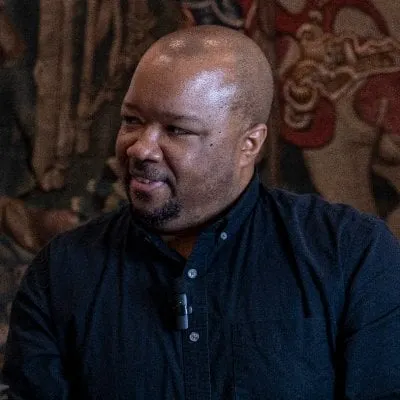Proving that blockchain gaming is not immune to downturns in the broader tech and crypto industries, ATMTA—the company behind the highly anticipated Star Atlas video game—revealed significant layoffs this week.
In an exclusive interview Tuesday, ATMTA co-founder and CEO Michael Wagner told Decrypt that the move was necessary to preserve the project’s long-term goals.
“We did have to lay off about 122 people from the team,” Wagner confirmed of the latest round of cuts, “so there's a sizable reduction in the labor force.”
Ultimately, ATMTA cut its team to 45 total people, down from a recent total of 167 people and slashed from the 2022 peak of 235 employees. An ATMTA representative told Decrypt that the total includes contractors and employees from partner studios that were tapped to co-develop the game, saying that "they've essentially been full-time team members."
News of the layoffs was first shared on the Star Atlas Discord server on Monday. Wagner cited market conditions and the need to adjust spending to “accommodate a long runway” as development on the Solana NFT-powered outer space game continues.
He said that ATMTA reevaluated its budget and development needs to ensure it can maintain its infrastructure, and said ultimately it was a process of “determining key personnel that will enable us to achieve our long-term vision and still build the variety of product lines that we have in development.”
Wagner acknowledged that the downsizing could impact game development, particularly when it comes to building out the robust, full-sized vision of the game using Unreal Engine, Epic Games’ industry-standard toolkit for “AAA” games.
“The biggest impact is probably to our flagship product line, the Unreal Engine team,” he said. “That's where we saw major reductions in our co-creation studio engagements.”
Funding AAA-level games is demanding and costly, Wagner added—so ATMTA will focus on products closer to release that can potentially create traction and increase revenue for Star Atlas, fueling its longer-term aims.
“While we make money every single month, we did not make enough money to cover the expenses of a AAA team that has a multi-million-dollar monthly run rate,” Wagner said. “So we’re scaling down the team to a more sustainable rate to get those products out, specifically focusing on the economy activation.”
While ATMTA is scaling back its staff, Wagner said the team is forging ahead and plans to rebuild its Unreal Engine team in time. The long-term target hasn’t changed, in other words, but the Star Atlas team is shifting gears amid a difficult crypto market and financial setbacks.
“We're not stopping Unreal Engine development,” he said. “Nothing about our vision has changed. We're only reprioritizing our efforts on those things that are more immediately repeatable, and we're leveraging that as a way to grow the user base and generate revenue in a more substantial amount.”
Not helping matters is the $16 million that ATMTA lost when FTX collapsed in November. At the time, Wagner said that the startup had lost about half of its funds, which became inaccessible when FTX closed withdrawals.
“We had $16 million on the exchange that was lost now,” Wagner said, adding that ATMTA recovered a “fairly substantial” portion of the funds lost by selling its claim to a distressed investment fund. He said the amount reclaimed in the sale was “less than 50%” of the amount held at FTX.
Despite the hardships, Wagner is optimistic about the future and building games on the Solana blockchain. Solana has faced significant challenges of its own over the past several months, including a wave of game and NFT projects that have either departed the chain or expanded outward to no longer be Solana-exclusive.
“We have been and continue to be extremely supportive of Solana and the innovation there,” Wagner said. “I genuinely believe the work that we're doing, building on on-chain gaming logic, is only possible on a network like Solana.”
Amid recent setbacks, Wagner wanted to reiterate that the company is pushing ahead, building products, and retaining its vision to bring Star Atlas to life.
“When we launched this in January 2021, we didn't have one dollar; we had a white paper and a dream,” he said. “We were able to generate hundreds of millions of dollars off of that vision. Even with hundreds of millions of dollars, that was never enough to get us to the completion of Star Atlas.”
“I don't think people should be surprised that we're scaling down in the current environment, when the reality was that we always needed to generate revenue,” Wagner added. “That was the only way this ever gets to completion, and we're still very much in that model. Nothing's changed there.”
GG Newsletter
Get the latest web3 gaming news, hear directly from gaming studios and influencers covering the space, and receive power-ups from our partners.

